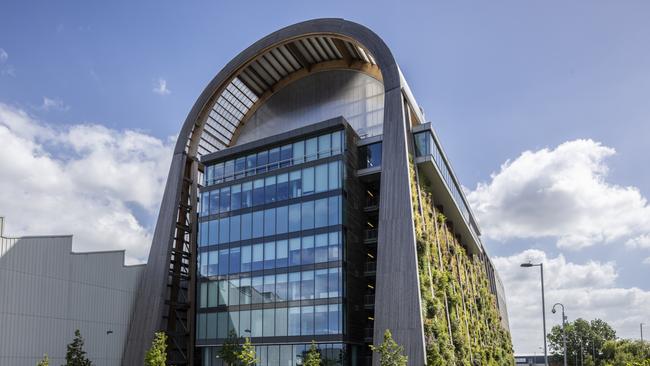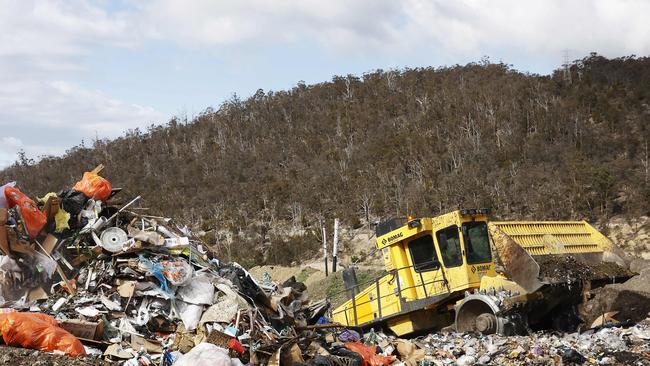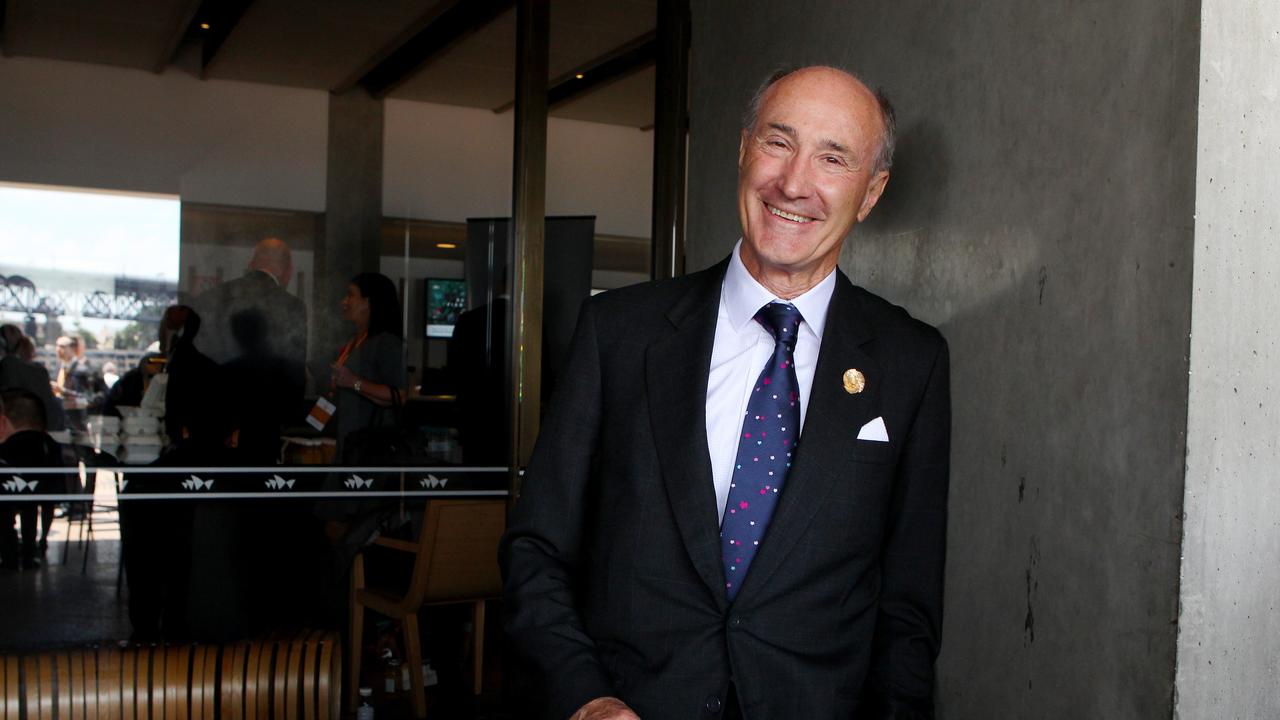Battle heats up in fight for $1.5bn worth of uncompleted waste to energy plants
The war for Australia’s red bin waste and what to do with it once it gets buried in landfill is at the heart of an escalating row between two global giants playing out on home soil.

Business
Don't miss out on the headlines from Business. Followed categories will be added to My News.
The battle between Acciona Australia and French firm Veolia over control of the waste-to-energy industry in Australia has escalated, with the Paris-headquartered company taking its fight to the competition regulator.
The Australian Competition and Consumer Commission is assessing whether Spanish giant Acciona and its Australian arm, run by Bede Noonan, can proceed with a planned purchase of the East Rockingham waste-to-energy plant after snapping up the only other plant, Kwinana, last year and firing Veolia from running it.
The two waste-to-energy plants have cost taxpayers, equity holders and lenders more than $1.5bn to build and neither plant has met its commercial brief. Both are located in Perth, and were to be built by Acciona and operated by Veolia.
Acciona was forced to buy out the equity owners in Kwinana, such as Macquarie, last year to keep it afloat; it then purchased all the senior debt in East Rockingham from its receivers for $460m, which it now wants to convert to equity. The uncompleted plant still has about $150m worth of building and commissioning costs before it is operational.
“We want to be the party that’s able to buy it,” Noonan told The Australian. “We are an operating business that thinks about risk and opportunity and would actively manage the asset.”
Acciona Australia is 80 per cent Spanish-owned.
As the only creditor, Acciona is in the box seat for East Rockingham, but Veolia is likely to put up a fight after being unceremoniously dumped from Kwinana. Infrastructure funds may also be interested.

“Someone would have to be willing to pay more than what our debt is worth... and the funding cost of the construction contract,” says Noonan. “It’s challenging because you’ve got to either find the banks who are willing to put finance in alongside you, or do 100 per cent equity.”
Receiver Barry Wright from Cor Cordis hired Moelis to handle the sale, which would likely need to top $700m to beat Acciona. Cor Cordis confirmed the Moelis process on Sunday, and that it signed a new engineering, procurement and construction contract with Acciona enabling project completion by mid-2026.
It’s simply by accident that Acciona Australia has ended up controlling two waste-to-energy plants in Australia.
Owing creditors $740m, East Rockingham fell into the hands of receivers last year, who promptly fired Acciona and all other contractors except Veolia.
Faced with the prospect of a complete wipe-out, Acciona doubled down by purchasing all the debt and after several months of lockout, Cor Cordis just rehired Acciona as the builder. The status of Veolia, which had the management contract of the incomplete plant, is unclear; it has not been terminated.
Veolia Australia CEO Richard Kirkman would not comment on Acciona’s proposed purchase.
“As we respect and remain under a confidentiality clause, we cannot comment on the status of the Kwinana and East Rockingham facilities, beyond saying we continue to honour all of our contractual requirements,” said a Veolia spokesman. “As a trusted and reliable partner, we make a point of upholding our contractual commitments.”
While it’s clear Acciona is prepared to provide the financial backing to complete both projects, Veolia has the global experience running them.
As for whether Noonan would like Veolia to remain as operator at East Rockingham, which he believes will be completed within 12 months: “I’m indifferent,” he says. “I have no adverse feelings toward Veolia.”
But clearly there are hard feelings all around.
In his first interview discussing the future of the two Perth plants, Veolia Australia’s boss articulates his position.
“We’re not the kind of organisation that wants to go to battle in court,” Kirkman says. “We’re not a big claim-based outfit like others. What we want to do is be collaborative and find ways to develop great outcomes for communities and customers. However, if we’re attacked, we will defend ourselves.”
The Englishman continues: “It’s about serving a population. Obviously, we want to make money, we’re a commercial outfit, but we want to do that in a way that local people are happy. There’s no consideration for that in these projects.”
Future of waste-to-energy
The mess around Kwinana and East Rockingham is a double negative for waste-to-energy’s believers. Investors and lenders have been burned, and while delays mount on the only two approved projects, it means Australia is on track to miss its target for reducing landfill. The two WA plants will eventually take 760,000 tonnes of red bin rubbish that would have otherwise gone into landfill in Perth and provide enough energy to power 86,000 homes.
Waste-to-energy plants incinerate rubbish at over 1000 degrees Celsius then convert the heat into steam to create energy. The steam is then cleaned through filters similar to those found in vacuum cleaners, with neutralising agents added and then released through smoke stacks as remarkably un-smelly vapour. In Europe they are monitored by regulators for emissions on a real time basis.
Chatting to the immediate neighbours at the London plant upon visiting the UK reveals a general level of comfort over the need to get rid of landfill, and, apart from one mother in a park about 100m from the incinerator chimney who remarked that it sometimes “is a bit smelly at night,” there is strong acceptance.
Veolia remains optimistic about its options on the east coast of Australia. The company is leading a $600m project in NSW’s Goulburn district, is involved in a similar-sized project in Victoria’s Latrobe Valley, and is watching closely the Gold Coast region where its council is mulling a $1.6bn project that includes a waste-to-energy component.
“In projects we are developing on the eastern coast, it’s about partnering with competent, considerate construction companies that know what they’re doing, with the right waste partners that know about waste and the right councils to get a good deal for the future of Australia in waste management,” Kirkman says.
Before moving to Australia to run Veolia, Kirkman oversaw the building of the Leeds plant in England’s north, which Veolia both constructed and operates. The Leeds plant cost £148m to build in 2016 (it would cost double that now) and takes all the red bin waste for the entire 1m population of Leeds, with none going to landfill. Energy generated from plant is enough to power 22,000 homes and, separately, steam generated from the plant is used to provide direct line heating through underground pipes to various buildings across the CBD.
In London, Veolia’s SELCHEP (South East London Combined Heat and Power) plant is located within striking distance of Millwall Football Club. “It’s got to go somewhere,” one mother watching her child dribbling a ball says of the rubbish (and echoing an infrequent stink).
In Australia, the federal and state governments use the same waste hierarchy model as Europe, prioritising ‘reduce’, then re-use, recycle, recover (where waste-to-energy sits). Landfill is the least preferred and lowest tier component.
Alternatives to landfill
Kirkman says one factor that would help at a federal level is if all landfill rates were equalised between states and regions and then raised, so councils and private waste operators aren’t tempted to just shift their garbage somewhere cheaper.
“The higher the levy on the landfill, the more waste you will push into either energy recovery or recycling or composting or just no waste being produced, because there’s that huge financial incentive not to produce waste. It’s all very well writing a policy we’re going to do more recycling, but what’s going to make people do it if there isn’t a financial benefit?”
In New South Wales, the government is conducting another review into energy from waste because under current forecasts, Greater Sydney will run out of landfill space in five years.
Veolia already landfills a million tonnes per year at Woodlawn (Goulburn), and would like to upgrade that to waste-to-energy.
“It makes sense, and the government and the EPA are supportive because otherwise we run out of landfill.”
In Victoria, the $600m Maryvale energy from waste project in the Latrobe Valley has planning permission and now requires signing up a builder. Acciona had been on that project in its early days, but is no longer.
As for the Gold Council, council is considering a $1.6bn Advanced Resource Recovery Centre at Staplyton. The plan includes eight facilities, including a waste-to-energy plant, which Kirkman compares to the Leeds project in being local-led.
“That’s how we think these projects should be developed with control by the customer, not merchant, not controlled by private entities that are just going to look after their own needs.”
The journalist travelled to the UK as a guest of Veolia.
More Coverage
Originally published as Battle heats up in fight for $1.5bn worth of uncompleted waste to energy plants




